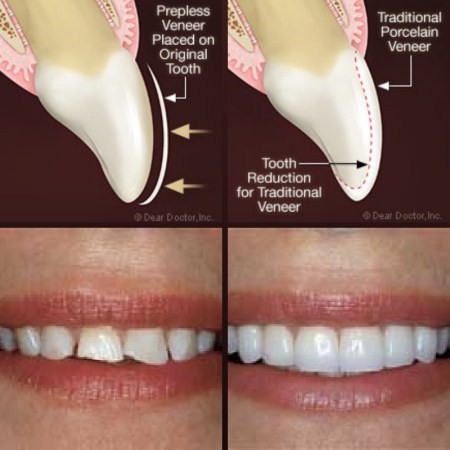VENEERS in Milpitas – Composite veneers are very thin shells that are used to conceal flaws in the shape, size, or color of your teeth. A special composite resin material is used to create these aesthetic restorations.
Composite resin is often used for fillings and tooth bonding, among other dental procedures. This tooth-colored resin restores your smile with lifelike results. Additionally, because they’re minimally invasive, you shouldn’t have any pain during or after the treatment.
Why Dental Veneers in Milpitas
Tetracycline, fluorosis, and amelogenesis are all linked to permanent stains in teeth.
Teeth that are cracked and worn
Tooth form that is abnormal
Minor malocclusion of the teeth
Crown and bridge facings that have been cracked can be repaired intra-orally.
The following are some of the limitations of dental veneers:
Bruxism and other irregular habits
Contact between the upper and lower teeth that is abnormal
Oral hygiene issues
Enamel structure is rare
Porcelain veneers vs. composite veneers
Composite resin isn’t the only veneer material out there. Another popular, but more expensive, veneer alternative is porcelain. Both composite and porcelain veneers can improve your smile, but your dentist may recommend one over the other based on your budget, purpose, and the level of enamel damage.
Let’s see how they compare.
Time
Porcelain veneers take longer to make and apply than composite veneers. Because they may be fitted in a single visit, they’re commonly referred to as “same day veneers.” It’s a simpler procedure that keeps more of the original tooth structure.
For a natural, blended look, your dentist will match the resin to the hue of your surrounding teeth.
You’re good to go once the veneer is attached to your tooth and polished.
The placement of porcelain veneers, on the other hand, usually necessitates at least two visits to the dentist. Porcelain veneers must be made in a dental lab outside of the office, and the treatment is slightly more invasive on the tooth structure. While you wait for your permanent veneers, you may need to wear temporary veneers. At the second appointment, your personalized porcelain veneers will be bonded to your teeth.
Aesthetics
Composite veneers are translucent and have a natural appearance, although they fall short of porcelain veneers in terms of natural appearance. Porcelain veneers are stain-resistant, which is a significant advantage. Get porcelain veneers and say goodbye to monthly teeth whitening procedures if you’re concerned about tooth discoloration. Composite resin has a natural appearance, but it can stain over time, albeit not as quickly as actual teeth.
Durability
Many studies predict that if veneers are properly cared for, they will retain 80–89% of their original value after 5 years. Porcelain veneers outperform composite veneers in this area, with a survival rate of 94.4 percent after five years, 93.5 percent after 10 years, and 91 percent after twenty years. Porcelain veneers are incredibly durable once bonded to teeth, however composite veneers are more likely to chip over time. Composite veneers may be mended rather easily, however porcelain veneers must be completely replaced if they become broken.
Cost
The cost of veneer treatment is determined by the amount of time, expertise, and resources available. Porcelain veneers are more expensive than composite veneers because they require more dentist appointments and resources, such as a dental lab. However, when it comes to durability, composite resin needs to be changed or mended more frequently than porcelain, which adds to the long-term expense.

